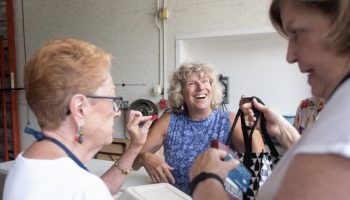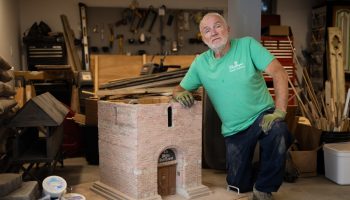
Megan Brown
Staff writer
When Callie Hawkins, CEO and executive director of President Lincoln’s Cottage, was pregnant with her first son, she read George Saunders’ novel Lincoln in the Bardo.
On Feb. 12, 2018, on Abraham Lincoln’s birthday, Hawkins’ son Coley was stillborn.
“Having read that and having had that experience of that story, when he died and was buried, I saw the cemetery as a sacred place,” Hawkins said. “And it wasn’t visiting there — it wasn’t about not being able to let him go — it was about feeling close to him.”
Through her work at Lincoln’s Cottage, Hawkins created the exhibit “Reflections on Grief and Child Loss,” not only to remember her son and to provide a place for others to grieve, but also as a commemoration for how Lincoln and his family had gone to the cottage after their son Willie died in February 1862. President Lincoln’s Cottage serves as both an historic site and museum in Northwest Washington D.C. The cottage is known as the location where Lincoln penned the Emancipation Proclamation.
This week, Hawkins, alongside Karla Helbert and Stacy Lynn, has led a collection of Masters Series classes, programmed through the Department of Education and Special Studies, called “Reflections on Grief and Child Loss,” “Grief Embodied, How Love and Loss Leave Their Mark” and “Grieving First Family, The Lincolns and Loss.”
Hawkins had originally reached out to Chautauqua Institution to collaborate in the summer of 2026 for the United States’ semiquincentennial; however, in her conversation with Jordan Steves, Emily and Richard Smucker Chair for Education, he shared that Saunders would be coming to Chautauqua in 2025 for the workshop of Lincoln in the Bardo, commissioned by the Metropolitan Opera. Lincoln in the Bardo follows Abraham Lincoln as he grieves the loss of his son Willie. While at his son’s crypt, Lincoln enters a bardo where he meets other spirits stuck in this transition state.
Grief and trauma therapist Helbert sees the bardo as an apt location, because it stems from the Buddhist tradition of a waiting place.
“All emotions, including grief — which is more than just an emotion — are energy, and it’s meant to flow,” she said. “… (The bardo) is just a really good illustration of when we don’t allow movement of energy, of emotion, of tears, of anything, then we get stagnant. And that’s never good.”
Helbert first became a therapist in 2000, originally working with children with autism or developmental disabilities. But when her son Thelonius “Theo” Luther Helbert Fueglein died of a brain tumor in 2006, her life was changed, and she became a grief therapist: something she hadn’t imagined being.
While the bardo works as a liminal space that reflects people unable to let emotions flow to Helbert, she also sees accurate representations of how people are afraid to interact with those experiencing grief. At Willie’s funeral, Lincoln looks at the mourners and knows they can’t wait to leave.
“People are so uncomfortable in that kind of pain that they want to just get away from it,” Helbert said. “So the hurtful things that they say, thoughtless things that they say, … are mainly to help themselves feel less uncomfortable. And most people can’t get away from us fast enough, especially right after in the aftermath, because they’re so just uncomfortable.”
For Helbert, another painful thing people say is that they can’t imagine what bereaved parents are going through. The character of Jack Manders, the groundskeeper in Lincoln in the Bardo, writes how he does not want to even think about his children dying. Another way people try to distance themselves, Helbert said, is by saying “I can’t imagine.”
“No, you can’t know what it’s like unless you’ve experienced it, but you can actually imagine it,” Helbert said. “George Saunders has imagined it beautifully, and it hasn’t happened to him. … Human beings have imagined things that do not even exist.”
Helbert originally connected with Hawkins when Hawkins contacted her about the “Reflections on Grief and Child Loss” exhibit. Her son Theo is now honored in the exhibit, too.
Hawkins described the weeping willow, a Victorian symbol for grief, that is the centerpiece of the exhibit. Participants can take a leaf off the tree, write their beloved’s name on it and place it back on the tree for them to be remembered.
“One of the goals of the exhibit was to honor the fact and create space because so few places in society exist to publicly honor the people we love who have died. And that was really important to us to be able to do,” Hawkins said. “… It’s validating to be able to have their name displayed in public. It’s a name that maybe they’ve only said in the quiet of their bedroom or their home, so to be able to do that in a public space is freeing in some ways.”
Hawkins first connected with Lynn, a Lincoln scholar, during the COVID-19 pandemic on a Zoom call about Mary Todd Lincoln.
“She and I bonded, both being bereaved mothers, both being women who had been out in the world defending Mary Lincoln for a long time, and so we stayed in touch,” Lynn said.
For 20 years, Lynn was an editor of Lincoln’s papers in Springfield, Illinois. As she learned more about Mary Lincoln, she had immense compassion for her.
“She was considered to be a woman who was pathologically grieving, that she was crazy, that she grieved too long,” Lynn said. “What I found in studying her life is she did grieve, and she suffered enormous loss and trauma: the death of three children; she was sitting next to her husband when he was violently murdered; and then her last surviving son had her incarcerated in a mental asylum. She suffered a great deal of loss, and her grief was real, but it was rooted in all the love that she had in her life.”
After Lynn lost her own child, Mackenzie, her scholarly relationship with the Lincolns grew into the book Loving Lincoln. Instead of simply a recounting Mary Lincoln’s life, this work includes both historical and personal essays and “blur(s) the lines between history and memoir.”
“My plan was to write a biography about Abraham Lincoln through the collective biographies of all the women who shaped his life and legacy,” she said. “When I sat down to write, I didn’t plan that my personal story and my grief and that grief itself would be a focus of the book, but it was, and it was natural.”
For Hawkins, the demonization of Mary Lincoln scared her in the aftermath of her son’s death.
“The awareness that I had of, if society does to me what it did to Mary Lincoln, I will not survive. This was completely paralyzing to me, and we have to do better as a society,” Hawkins said. “This woman survived so much, yet her legacy has been distilled to one of craziness and being unhinged, and this is something that scholars today will still argue. And for a young mother who has just lost her child, to have that thought — we have got to do better, because it’s completely unfair and unfounded, and it has consequences today for people still, 150, 160 years later, it still has an impact on people.”




